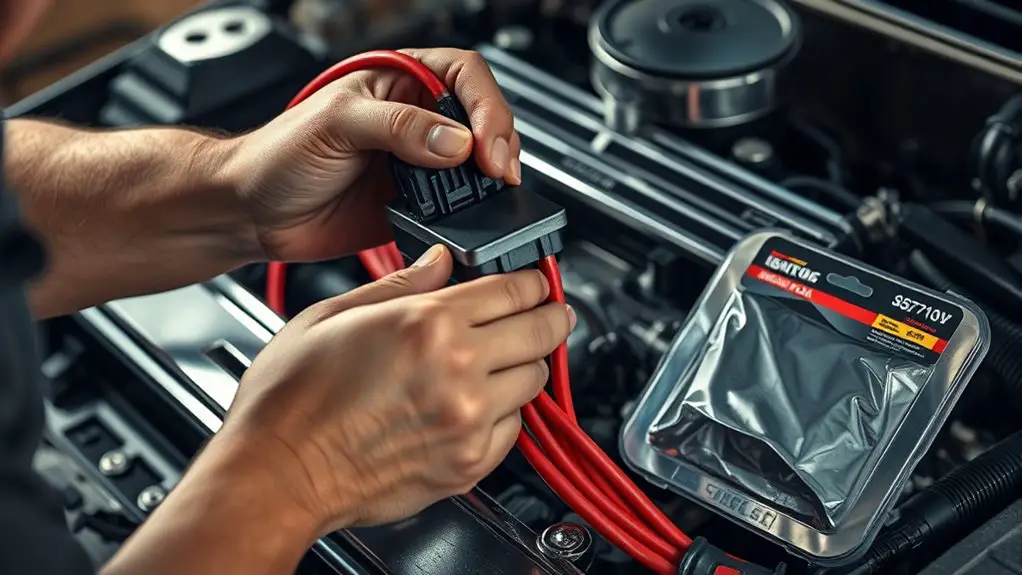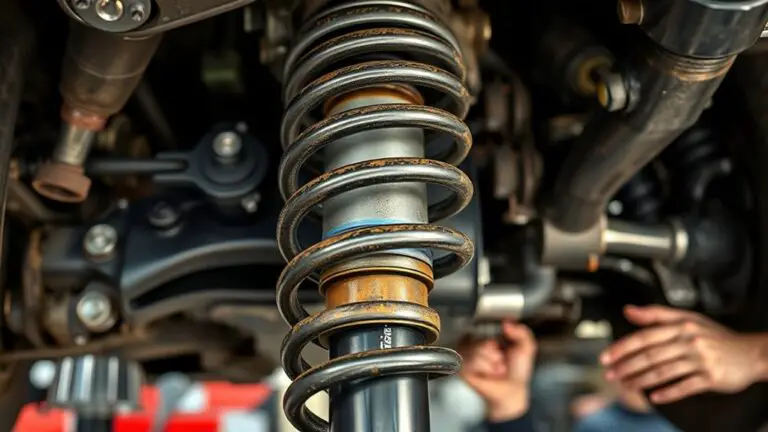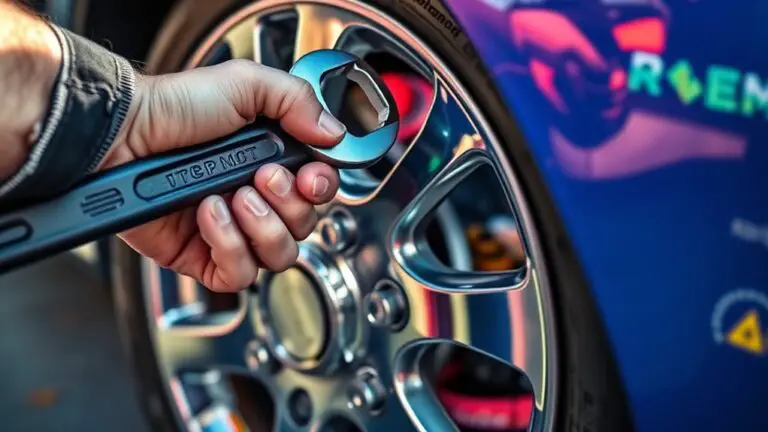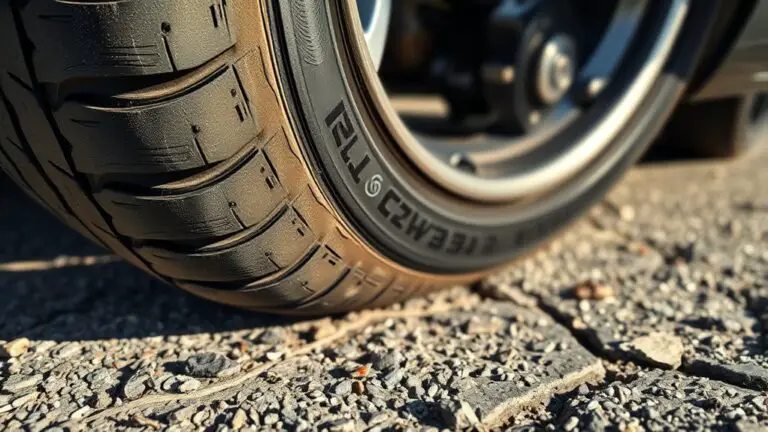Step-By-Step: Fixing Engine Knocking/Pinging Caused by a Bad Ignition Coils
To fix engine knocking or pinging due to bad ignition coils, first, identify the symptoms like metallic rattling during acceleration. Gather necessary tools, then locate and inspect the ignition coils for damage. Test their functionality using a multimeter. If faulty, replace them securely and make sure all connections are tight. Finally, restart the engine and monitor for abnormal sounds or performance issues. Follow these steps for thorough guidance on achieving peak engine performance.
Understanding the Symptoms of Engine Knocking/Pinging
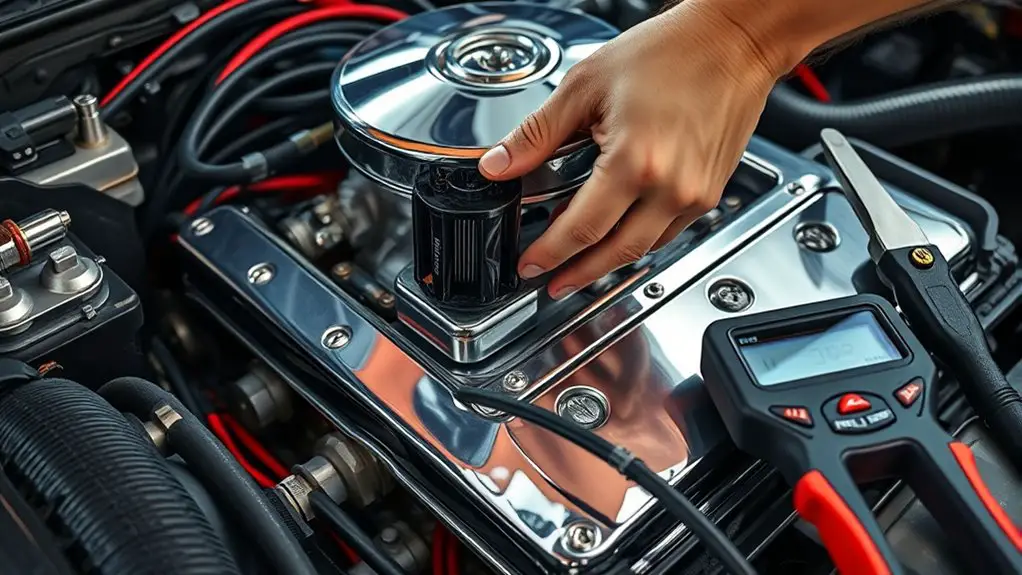
Engine knocking or pinging is often noticeable under specific conditions, and recognizing the symptoms early can save you from costly repairs. Knocking typically occurs when fuel ignites prematurely in the combustion chamber, while pinging results from abnormal combustion patterns. Common knocking causes include low octane fuel, excessive engine heat, or improper air-fuel mixture.
You might notice a metallic rattle or a distinct ticking sound, especially during acceleration. This noise often indicates that your engine’s efficiency is compromised.
To guarantee pinging prevention, keep your fuel system clean and use high-quality gasoline with the appropriate octane rating for your vehicle. Regular maintenance, like checking spark plugs and engine timing, is essential. If you hear knocking or pinging, don’t ignore it—addressing these symptoms early can help you maintain your vehicle’s performance and extend its lifespan. Prioritize your freedom on the road by staying vigilant.
Identifying the Role of Ignition Coils

Ignition coils play a vital role in your engine’s performance by converting battery voltage into the high voltage needed to ignite the air-fuel mixture. If these coils fail, you might notice symptoms like misfiring, poor acceleration, or even engine knocking. Understanding their functionality and failure signs is essential for troubleshooting engine issues effectively.
Ignition Coil Functionality
While you may not think about them often, ignition coils play an essential role in your vehicle’s engine performance. They convert battery voltage into the high voltage needed to create a spark in the spark plugs, igniting the air-fuel mixture in the combustion chamber. Different ignition coil types, such as coil-on-plug and traditional distributor coils, impact how effectively this process occurs. Your engine’s coil performance can greatly influence acceleration, fuel efficiency, and overall power output. When ignition coils function properly, they guarantee a smooth engine operation; however, any degradation can lead to issues like knocking or pinging. Understanding their functionality helps you appreciate the importance of maintaining these components for peak engine health.
Symptoms of Failure
When ignition coils start to fail, you may notice several symptoms that can impact your vehicle’s performance. Different ignition coil types can exhibit distinct signs of deterioration. Here’s a quick reference to help you identify potential issues:
| Symptom | Description | Impact on Performance |
|---|---|---|
| Rough Idling | Engine shakes or vibrates | Decreased stability and power |
| Poor Acceleration | Sluggish response when accelerating | Slower speed and responsiveness |
| Engine Misfires | Unusual popping sounds | Reduced efficiency and power loss |
Recognizing these symptoms early can save you from more significant engine problems down the road. Addressing ignition coil issues promptly will enhance your engine performance and maintain your vehicle’s freedom on the road.
Gathering Necessary Tools and Equipment

To effectively address engine knocking or pinging, you’ll need a few essential tools and equipment. Start with a basic mechanic’s toolset, which typically includes socket wrenches, screwdrivers, and pliers. These will help you access and remove the ignition coils. You’ll also want a torque wrench to guarantee proper installation of the new components.
Next, gather a multimeter to test the electrical functionality of the ignition coils before replacement. This can save you time and hassle. Don’t forget safety gear, like gloves and goggles, to protect yourself while working.
Lastly, having a repair manual specific to your vehicle model can be invaluable for locating components and following procedures. By gathering these tools and essential equipment, you’ll be well-prepared to tackle the issue effectively, assuring you can restore your engine’s performance and enjoy the freedom of the open road.
Locating the Ignition Coils in Your Vehicle
To effectively address ignition issues, you need to locate the ignition coils in your vehicle. Understanding their placement is essential for troubleshooting and repairs. You’ll also require specific tools to assist in this process.
Understanding Ignition Coil Placement
Understanding the placement of ignition coils in your vehicle is crucial for effective engine performance. Ignition coils, whether they’re traditional or coil-on-plug types, play a significant role in the combustion process. Their location can impact accessibility for maintenance and replacement. Here’s a quick reference table to help you identify typical ignition coil placements:
| Ignition Coil Type | Typical Location |
|---|---|
| Traditional Ignition | Near the engine block |
| Coil-on-Plug | Directly on each spark plug |
| Distributor-Based | Next to the distributor |
| Dual-Spark Coil | At the top of the cylinder head |
| Aftermarket Upgrades | Varies by vehicle make/model |
Proper ignition coil maintenance is crucial. Regular checks can prevent knocking or pinging issues and guarantee peak engine performance.
Tools for Locating Coils
Locating ignition coils in your vehicle can be straightforward with the right tools. Start by gathering essential ignition system tools such as a digital multimeter and a step-by-step service manual for your specific make and model. These coil identification techniques will help you pinpoint the exact location of the coils. Use the multimeter to test for voltage at each coil, ensuring your diagnostic process is efficient. A flashlight can also be invaluable for inspecting hard-to-reach areas. Don’t forget to have a socket set handy for easier removal of components blocking access to the coils. With these tools at your disposal, you’ll navigate the ignition system with confidence and clarity, allowing for a successful diagnosis and repair.
Inspecting Ignition Coils for Damage
Inspecting ignition coils for damage is essential for diagnosing engine knocking or pinging issues. Begin by visually examining each coil for cracks, corrosion, or signs of overheating. A damaged ignition coil can lead to poor engine performance, so regular ignition coil maintenance is critical.
Here’s a quick reference table to help you identify potential issues:
| Damage Type | Symptoms | Coil Replacement Tips |
|---|---|---|
| Cracks | Misfiring, rough idle | Replace immediately |
| Corrosion | Poor fuel economy | Clean contacts before replacement |
| Overheating | Engine vibration | Check for electrical shorts |
| Loose connections | Intermittent issues | Tighten connections securely |
| Burn marks | Engine stalling | Consider full coil replacement |
If you notice any of these issues, it’s wise to proceed with coil replacement to maintain the best possible engine performance.
Testing Ignition Coils for Proper Function
Before you can determine if your ignition coils are functioning properly, it is crucial to conduct a series of tests to evaluate their performance. Start with ignition coil testing, which involves checking the electrical output and ensuring each coil is firing correctly. Use a multimeter to perform coil resistance measurement; refer to your vehicle’s specifications for the correct resistance range.
Disconnect the ignition coils from the wiring harness and measure the resistance across the primary and secondary terminals. If the readings are outside the specified range, the coil may be faulty.
Next, consider conducting a spark test by reattaching the coils and connecting them to the spark plugs while grounding them to the engine. Crank the engine and observe for a strong, consistent spark. If you notice weak or no spark, it indicates a problem with the ignition coils that needs addressing before moving on to replacement steps.
Replacing Faulty Ignition Coils
If you’ve confirmed your ignition coils are faulty, replacing them is vital for restoring engine performance. Start by identifying the ignition coil types specific to your vehicle, as compatibility is essential. You’ll typically find either conventional or coil-on-plug designs. Gather the necessary tools, including a socket set and torque wrench.
Next, disconnect the battery to prevent electrical issues. Remove the old ignition coils by detaching the connectors and unscrewing them from their mounts. Install the new coils by reversing this process, making sure they’re securely fastened and the connectors are properly attached.
Coil replacement costs can vary notably, ranging from $50 to $200 per coil, depending on the type and your vehicle’s make and model. Always consider purchasing quality parts to guarantee longevity and performance. Once installed, your engine should run smoother, eliminating the knocking or pinging you’ve been experiencing.
Reassembling and Reconnecting Components
Reassemble the engine components carefully to confirm everything functions smoothly. Start by positioning the ignition coils back in their designated spots. Make certain you align them correctly to avoid any future issues. Next, focus on reconnecting wires; verify each wire is firmly attached to prevent any electrical failure.
| Component | Importance |
|---|---|
| Ignition Coils | Essential for ignition |
| Wiring Connections | Critical for functionality |
| Engine Cover | Protects internal parts |
Each component plays a significant role in your engine’s performance. As you’re reassembling components, take your time and double-check connections. A secure fit is important to maintain your engine’s health and ultimately provide you with the freedom of a smooth drive. Once everything’s back in place, you’ll be one step closer to enjoying your vehicle again.
Performing Final Checks and Testing the Engine
After reassembling the engine, it’s essential to conduct final checks and testing to guarantee peak performance. Start by inspecting all connections and ensuring components are secured properly. Check the ignition coils, as any loose wiring can lead to engine knocking or pinging. Use diagnostic tools to scan for error codes, which can reveal underlying issues affecting engine performance.
Next, perform a visual inspection for leaks around the intake and fuel systems. Once you’re satisfied with the checks, start the engine and listen for abnormal noises. Monitor the engine’s RPM and performance under different conditions. If everything sounds and feels right, take the vehicle for a short test drive to assess performance on the road. Pay attention to any lingering knocking or pinging sounds. If issues persist, revisit your previous steps or consult a professional for further assistance.
Frequently Asked Questions
How Long Does It Take to Replace Ignition Coils?
Replacing ignition coils typically takes about 1 to 2 hours, a brief passage through the tunnel of your vehicle’s inner workings. Given the average ignition coil lifespan of 60,000 to 100,000 miles, you might face a replacement cost ranging from $100 to $300 per coil, depending on your vehicle. While this task isn’t overly complex, it’s essential for maintaining your engine’s rhythm and ensuring your driving freedom isn’t interrupted by unwanted noise.
Can Bad Ignition Coils Cause Other Engine Problems?
Yes, bad ignition coils can definitely cause other engine problems. When ignition coil effects lead to misfires, it negatively impacts engine performance, resulting in reduced power and fuel efficiency. This can also trigger the check engine light, which may mask other underlying issues. Over time, continuous misfiring may damage spark plugs, catalytic converters, and even the engine itself. So, addressing faulty ignition coils promptly is essential for maintaining ideal engine health.
What Are the Signs of a Failing Ignition Coil?
You’ll know your ignition coil’s failing when you notice a few telltale symptoms. Expect misfiring, rough idling, and decreased fuel efficiency to pop up. You might even feel your engine struggling during acceleration. If your check engine light flickers, don’t ignore it; that’s a sign of coil failure. These issues can lead to more significant problems, so addressing them quickly can save you from a costly repair down the road.
Should I Replace All Ignition Coils at Once?
Yes, you should replace all ignition coils at once. Ignition coil types can vary in lifespan, and if one fails, others might soon follow. Replacing them together guarantees consistent performance and prevents future issues, providing coil replacement benefits like improved fuel efficiency and smoother engine operation. It’s a proactive approach that can save you time and money in the long run, allowing you to enjoy a reliable driving experience without unexpected disruptions.
Can I Use Aftermarket Ignition Coils Safely?
Absolutely, you can use aftermarket ignition coils safely. However, it’s essential to choose reputable brands known for aftermarket reliability. While these coils can provide solid ignition performance, quality varies, so research is key. Some aftermarket options may enhance your engine’s efficiency, but others might not meet OEM standards, potentially leading to issues down the line. Always read reviews and consult trusted sources to guarantee you’re making an informed choice.

